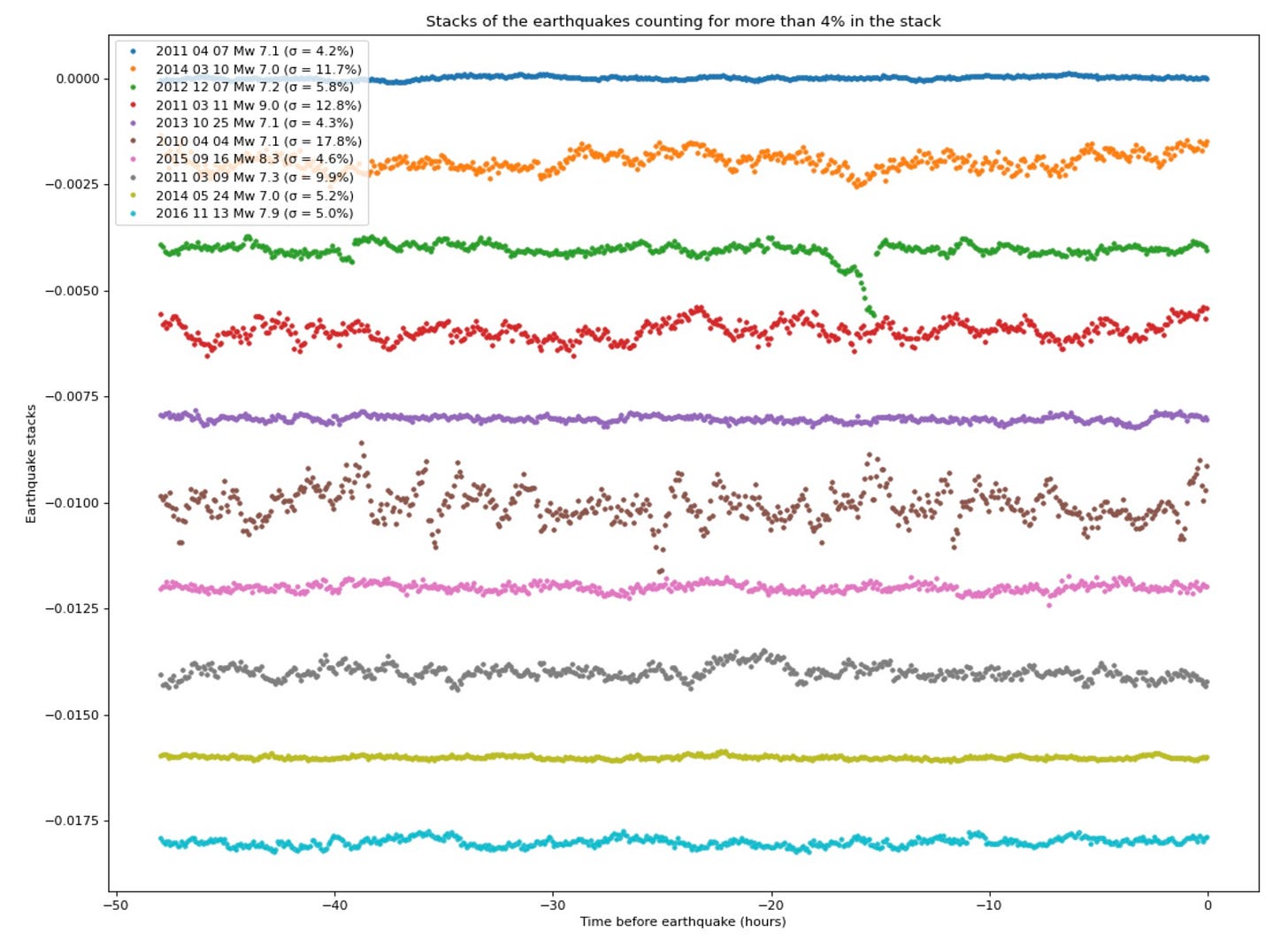Update on apparent GPS detection of earthquake precursors
We generate the same "signal" using only noise from far-field stations
Citation: Bradley, K., Hubbard, J., 2023. Update on apparent GPS detection of earthquake precursors. Earthquake Insights, https://doi.org/10.62481/479c2ea4
If this post has reverted to behind a paywall, download a pdf here. All of our analyses of recent research papers are intended to be permanently free to read and comment to allow open discussion by the scientific community.
A few days ago, we started looking at the data underlying a recent Science paper that claims to detect precursory slip in the hours before large (M>7) earthquakes.
Here are a few more observations and visualizations of the data to support the argument that the purported signals arise from noise unrelated to earthquake precursors.
Below, we show a movie of the X (East) component for the Japanese GPS network in the two days preceding the 2011-03-11 Tohoku-Oki earthquake.
The left panel shows the original time series data, where the mean displacement for each component has already been subtracted from each time series (simply centering each component around 0). The color shows the amplitude of the signal at each station; red means that the station is moving to the east, and blue means it is moving to the west. The inset shows the average value of all sites over time. These data are equivalent to the data that were dot-producted and stacked in the original publication. The movie illustrates how waves of east-west motion propagate around mainland Japan, often affecting the entire island. In other words, common mode noise affects the whole network.
The right panel shows the same data after removal of the common mode noise, which is the average signal of all sites >200 km from the eventual hypocenter location. Note that there are no apparent excursions for sites located on the northeast coast - which would be sensing any precursory slip.
In our previous post, we showed that when the common mode noise is removed from the time series for each earthquake, the “precursory signal” disappears. In this follow-up, we asked ourselves what the re-analysis would look like if we only used the inferred common mode noise from each GPS network in the dot product stack. Since the common mode noise is calculated from far-field stations (located more than 200km from the eventual hypocenter location), where predicted displacements due to precursory slip would be so small as to be undetectable, any apparent precursor signal in the resulting stacks cannot be attributed to precursory slip in the hypocenter region.
So, we replaced the original GPS time series data files with the common mode time series calculated for each earthquake, and then re-ran the analysis code provided by the authors. The per-earthquake stacks below show the common mode noise that has been filtered through the dot product function and stacked. The earthquakes with the largest amplitude noise are the 2014-03-10 Mw7 earthquake offshore of northern California, the 2011-03-11 Mw9 Tohoku-Oki earthquake, the 2010-04-04 Mw 7.1 El Mayor-Cucapah earthquake, and the 2011-03-09 Mw7.3 Tohoku-Oki foreshock. Interestingly, for these large amplitude stacks, all but the March 9, 2011 earthquake show a positive swing in the hours before the mainshock - in addition to many similar swings in the days before the mainshock.

Because these time series are added together to get the global signal, the global stack also shows a positive trend at the end of the time series - as in the figure below. An exponential fit function for the final points in the time series shows a M6.4 equivalent event that rises over the several hours before the mainshock. This is similar to the hockey stick pattern that is interpreted as precursory slip in the original paper. However - this signal arises only from displacements of far-field GPS sites; it does not include any data from stations within 200 km of the earthquake hypocenter locations.

So it seems clear to us that the 2-hour precursor signal is a coincidence: the three GPS time series with largest-amplitude common mode noise also happen to have positive upswings in the hours before the mainshock events. The other earthquakes contribute very little to the final stack due to combination of smaller noise signals or few time series. Fortunately, removal of the far-field noise does seem like a feasible strategy for looking at underlying signals in the regional networks and perhaps future work will find earthquake phenomena there.
We continue to conclude that the signal in this paper seems to arise from an unfortunate coincidence of correlated GPS noise in three large regional networks, and cannot be attributed to any earthquake process.
Thanks to those who commented on the previous post! As a result, we learned some new things about GPS time series processing.
References:
Bletery, Q. and Nocquet, J.M., 2023. The precursory phase of large earthquakes. Science, 381(6655), pp.297-301. https://doi.org/10.1126/science.adg2565
Bradley, K., Hubbard, J., 2023. Earthquake precursors? Not so fast.. Earthquake Insights, https://doi.org/10.62481/310cc439



Great detective work!